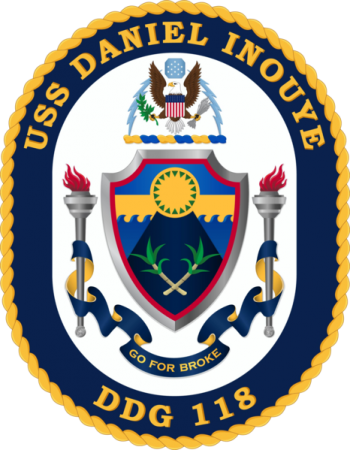Destroyer USS Daniel Inouye (DDG-118): Difference between revisions
No edit summary |
Knorrepoes (talk | contribs) m (Text replacement - "{{media}}↵" to "") |
||
| Line 19: | Line 19: | ||
[[Literature]]:Image from Wikimedia Commons. Blazon and Information from https://dkii.org/uss-daniel-inouye-ddg-118/#blazon | [[Literature]]:Image from Wikimedia Commons. Blazon and Information from https://dkii.org/uss-daniel-inouye-ddg-118/#blazon | ||
[[Category:Military heraldry of the United States]] | [[Category:Military heraldry of the United States]] | ||
[[Category:Navy heraldry]] | [[Category:Navy heraldry]] | ||
Revision as of 12:25, 27 December 2022
US heraldry portal
This page is part of the US heraldry portal |
Heraldry of the World |
|
US heraldry:
|
Ecclesiastical Heraldry of the USA:
Military Heraldry: |
DESTROYER USS DANIEL INOUYE (DDG-118)
Official blazon
Shield. Celeste, a chief crested per fess of the first and Or, a pile reversed Azure (Dark Blue), superimposed at tip with a bezant charged with an annulet of eighteen triangles Vert, at base two sugar cane plants saltirewise Proper; all within a diminished border Gules.
Crest. From a wreath of the colors Or and Celeste, two lightning bolts arched chevronwise Celeste (Bluebird), surmounted by an eagle displayed holding in dexter claw a laurel branch, in sinister claw thirteen arrows, bearing the Coat of Arms of the United States, in chief a Medal of Honor neck pad, all Proper.
Supporters. On either side of the shield, a torch palewise Argent (Silver Gray), enflamed Gules.
Motto. A scroll Azure (Flag Blue), doubled Or, with the inscription “GO FOR BROKE” of the last.
Origin/meaning
Shield. Blue and gold are traditional colors associated with the U.S. Navy. The dark blue pile reversed is a stylized characterization of Diamond Head, Hawaii’s most recognized monument and former home to the first United States military reservation in Hawaii, Fort Ruger. The landmark is located in Honolulu, the birthplace of Daniel Inouye as well as where he conducted much of his life’s work. Diamond Head sits on the coast of the island of Oahu, the ocean represented here by the waves. Present on the Honolulu flag and Hawaii state seal, the sun is emblematic of a new day and, therefore, the birth of a new state. Forming the sun, the green triangles are the Hawaiian symbol for `Aina or land. They reflect Senator Inouye’s commitment to indigenous peoples, specifically his service as Chairman of the Senate Indian Affairs Committee and his work which led to the inauguration of the Smithsonian National Museum of the American Indian. The green coloring of the triangles is a reference to Inouye’s service in the U.S. Army. The two sugar cane plants at base highlight the fact that Senator Inouye’s father and grandparents came to the United States as laborers in the sugar cane fields. This further reflects the gratitude Inouye often expressed for living in a democracy with boundless opportunities. The red border suggests Inouye’s Japanese ancestry.
Crest. The wreath adopts the first named metal and color from the shield and blazon. The eagle is adapted from the U.S. Senate seal and is indicative of Inouye’s tenure as a Senator where he rose to become President Pro Tem and third in succession to the presidency. He was elected to the Senate in 1962 where he served for 49 accomplished years until his death in 2012. Senator Inouye was a proud American continually focused on making the United States a better place. The lightning bolts are expressive of the speed and sophistication of the warship. Their arched position is an allusion to the flanking maneuver Inouye, while a Second Lieutenant, led his platoon in during the Assault on Colle Musatello in Italy in 1945. Inouye’s exceptional leadership, valor and devotion to duty during this assault resulted in his being awarded the Distinguished Service Cross. In 2000, his award was upgraded to the Medal of Honor after an official review found that many Japanese-American servicemen had been denied proper recognition of their bravery due to their race. The neck pad in chief represents the Medal of Honor awarded to Senator Inouye. It is placed higher than everything else within the coat of arms, denoting it as the nation’s highest honor for valor in combat.
Supporters. The torches represent guidance and leadership through strength and are derived from the 442nd Infantry Regiment insignia where Inouye was a member during World War II. At the base of each torch, a silver coin is attached, referencing the two silver dollars Inouye kept as good luck charms in his breast pocket during his service with the Regiment. During an attack in a battle to relieve the Lost Battalion in 1944, the silver dollars deflected a bullet from hitting his heart, thereby saving his life.
Literature:Image from Wikimedia Commons. Blazon and Information from https://dkii.org/uss-daniel-inouye-ddg-118/#blazon





